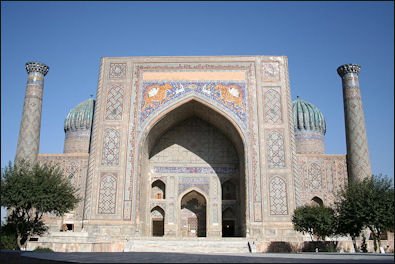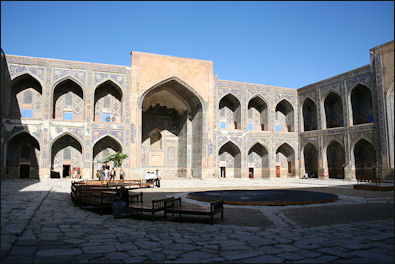Home | Category: Muslim Education, Government and Finance
EDUCATION IN MUSLIM AREAS
.jpg)
Bosnia Medresa in 1906 A high value is placed on education in both Islamic and Arab societies. A verse from the Qur’an goes “O God, make me more knowledgeable.” Muhammad once said, “he who leaves the home in search of knowledge is walking with God. One Hadith states: “Seek knowledge from the cradle to grave.” An old Arab saying goes: "The ink of the scholars is more precious than the blood of the martyrs." Islamic scholars have compared the relationship between the knowledge and the mind with food and the body.
Non-religious schools only became widespread after the Arab countries became independent and free of European control after World War I. It took some time to develop a curriculum in Arabic for a wide range of subjects.
Spending on education in the Arab world is higher than other countries in the developing world. Even so, according to the Arab Human Development Report, put together by a group of Arab intellectuals, there is an “Arab knowledge deficit.” According to the report the “patriotic” education system is designed to serve the needs of the ruling regime more than it is to educate students.
Websites and Resources: Islam IslamOnline islamonline.net ; Institute for Social Policy and Understanding ispu.org; Islam.com islam.com ; Islamic City islamicity.com ; BBC article bbc.co.uk/religion/religions/islam ; University of Southern California Compendium of Muslim Texts web.archive.org ; Encyclopædia Britannica article on Islam britannica.com ; Islam at Project Gutenberg gutenberg.org ; Muslims: PBS Frontline documentary pbs.org frontline
RECOMMENDED BOOKS:
“Schooling Islam: The Culture and Politics of Modern Muslim Education” by Robert W. Hefner and Muhammad Qasim Zaman Amazon.com ;
“Faithful Education: Madrassahs in South Asia” by Professor Ali Riaz Amazon.com ;
“What is a Madrasa?” by Ebrahim Moosa Amazon.com ;
“Inside a Madrasa: Knowledge, Power and Islamic Identity in India”
by Arshad Alam Amazon.com ;
“Female Madrasas in Pakistan: Religious, Cultural and Pedagogical Dimensions’ by Faiza Muhammad Din Amazon.com ;
“The Holy Quran” Arabic Text English Translation (English and Arabic Edition) Leather Bound
Amazon.com ;
“The Study Quran: A New Translation and Commentary” Amazon.com ;
“The Story of the Qur'an: Its History and Place in Muslim Life” by Ingrid Mattson Amazon.com ;
Muslim Education
Many Islamic countries offer four education systems: 1) home study in arithmetic, language and the Qur’an; 2) studying at a mosque or another building in arithmetic, language, Islam and the Qur’an; 3) study at a mosque or another building in arithmetic, language, Islam, the Qur’an and additional subjects; and 4) schools.
Traditional Islamic education involves religious study — which embraces not only theology but also law and history, as well as classical Arabic language — and study of logic, mathematics and sometimes Arab writers and poets like Kahlil Gibran. The links between education advancing Muslim culture are very strong. Many Muslim extremist develop their views at schools that teach an extremist ideology. Lower education stresses memorizing the Qur’an, curriculum religion, Arabic and arithmetic; higher education is in the form of a running discussion. In the old days the world was largely seen as signs from God and students were taught to look for and recognize these signs.
Charles F. Gallagher wrote in the “International Encyclopedia of the Social Sciences”: The traditional religious instruction of the mosque-school, usually limited to rote Qur’anic studies and the rudiments of mathematics and civics, has been supplemented or replaced now almost everywhere by modern educational facilities, which attract a majority of the children of school age in many Muslim countries. These uniformly supply religious instruction, however, and thus young men even today, in contrast with modern Westerners, possess a detailed knowledge of their scripture, which serves as a further channel for maintaining Islamic solidarity. The education of girls, previously much neglected, has made great strides in recent decades. Nevertheless, many fewer girls than boys attend school, and even fewer go on to higher education. In some countries women are entering the professions in small numbers and working in salaried positions for the first time, but marriage and housekeeping are still considered their proper occupations. [Source: Charles F. Gallagher, “International Encyclopedia of the Social Sciences”, 1960s, Encyclopedia.com]
Anna Kuchment wrote in Newsweek: “The narrow-mindedness of groups like the Taliban is hardly an Islamic ideal. "Seek knowledge from the cradle to the grave," counsels the Hadith, the traditional sayings of the Prophet Muhammad. The first Muslims followed that advice enthusiastically. "Traditional Islamic education encompassed both what we would call religious education and the hard and soft sciences — logic, astronomy, mathematics," says Alan Godlas, professor of Islamic studies at the University of Georgia. "The world was seen to be nothing but the signs of God. Muslims were supposed to study the world so they could study the signs of God." In fact, Muslim scholars preserved and expanded on classical Greek thought through the early Middle Ages, while Europe wallowed in illiterate brutality. "Without Islamic and Arab scientists and thinkers, the European Renaissance would not have occurred," says Taj Hargey, a professor of African history at New York's Sarah Lawrence College. [Source:Anna Kuchment, Newsweek, March 10, 2002]
“Over the centuries the emphasis of Islamic scholarship changed. "After the 13th-century Mongol invasion, stagnation set in," says Yahiya Emerick, a popular U.S. writer on Islam. Schools stressed recitation of the Qur'an above understanding its message. The problem grew as Islam spread outside the Arabic-speaking lands. Most Muslims, believing that God personally dictated the Qur'an, distrust translations.
“Now some Islamic educators are questioning the value of rote memorization. "We still have imams trained in Muslim countries, who know how to recite but not how to reflect and think about the Qur'an in the context of modern British life," says Abdullah Sahin, a researcher in Islamic education at the University of Birmingham. "Islamic education is reduced to learning the outward features of the book, not necessarily the content." Hargey agrees: "If you read the Qur'an properly, it appeals to the head. It repeats, 'Can you not understand?' 'Can you not see?' It engages the believer based on reason."
Arab and Muslim Science and Scholarship
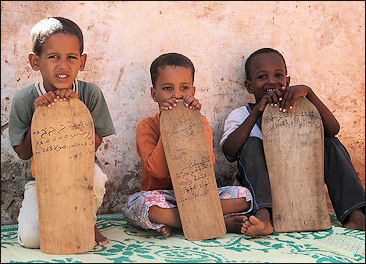
Madrasah pupils in Mauritania During the 8th, 9th and 10th century when Europe was is in the Dark Ages, the Arab world was incorporating elements of the great civilizations around them—India, China and Byzantium— and producing a great culture of their own.
Among other things, the Arabs were very interested in Greek science and philosophy. They were reading Plato and Aristotle when they had long been forgotten in the West. The study of the Greeks is credited with incorporating reason into Islamic thought and causing tensions between those who favored reason and those that followed a strict interpretation of the religious scriptures.
In the early Middle Ages, the Muslim kingdoms were the intellectual centers of the world. The Al-Azhar University in Cairo had 12,000 students and the library in Cordoba contained 400,000 manuscripts. Mosques and madrasahs were the primary centers of learning, but because of what was studied there was of a religious nature, scientific and philosophical studies were supported primarily by the courts of rulers and wealthy people.
See Separate Article: SCIENCE IN THE EARLY ISLAMIC PERIOD africame.factsanddetails.com
Education and the Qur’an
Reciting the Qur’an is the backbone of Muslim education. Traditional Islamic rural schools teach the Qur’an and Arabic religious texts and little else. At some extreme schools, Instead of reading, writing and arithmetic the boys learn the world is flat and that anything not mentioned in the Qur’an or are not part of Islamic science are not important. Similar situations are also found at extreme Christian and Jewish schools. One should keep in mind there are likely as many, if not more, followers of Christianity or Judaism who reject modern scientific theory.
Learning to read and write in many Muslim schools is a process or memorizing all 114 chapters of the Qur’an. This is done by reciting passages over and over and copying pages of the Qur’an, sometimes on wooden tablets with quill pens dipped in ink made from charcoal and gum arabic. A boy becomes a man in many Muslim societies when he recites verses during a ceremony during adolescence.
Expressing what is required of a good Islamic scholar, a 12th century medical scholar from Baghdad wrote: “When you read a book, make every efforts to learn it by heart and master its meaning. Imagine the book to have disappeared and that you can dispense with it, unaffected by its loss...You should model your conduct on that of the early Muslims. Therefore, read the biography of the Prophet, study his deeds and concerns, follow his footsteps and try your utmost to imitate him...You should frequently distrust your nature rather than have a good opinion of it, submitting your thoughts to men of leaning and their works, proceeding with caution and avoiding haste...He who has not endured the stress of study will not taste the joy of knowledge.”
See Separate Article: READING, RECITING, LEARNING AND MEMORIZING THE QUR'AN africame.factsanddetails.com
Traditional Islamic Education
Reciting the Qur’an is the backbone of Muslim education. Traditional Islamic rural schools teach the Qur’an and Arabic religious texts and little else. Instead of attending a normal secular school many young Muslim boys are sent to a small local Muslim schools to memorize not read the Qur’an. Instead of reading, writing and arithmetic the boys learn the world is flat and that anything not mentioned in the Qur’an or are not part of Islamic science are not important.
Learning to read and write in many Muslim schools is a process or memorizing all 114 chapters of the Qur’an. This is done by reciting passages over and over and copying pages of the Qur’an, sometimes on wooden tablets with quill pens dipped in ink made from charcoal and gum arabic. A boy becomes a man in many Muslim societies when he recites verses during a ceremony during adolescence.
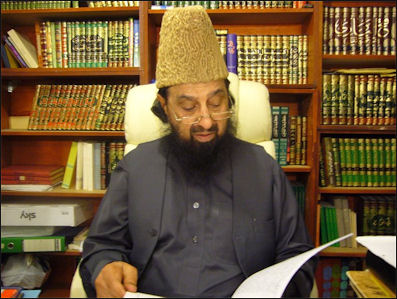
Sheikh Syed Abdul Qadir Jilani Expressing what is required of a good Islamic scholar, a 12th century medical scholar from Baghdad wrote: “When you read a book, make every efforts to learn it by heart and master its meaning. Imagine the book to have disappeared and that you can dispense with it, unaffected by its loss...You should model your conduct on that of the early Muslims. Therefore, read the biography of the Prophet, study his deeds and concerns, follow his footsteps and try your utmost to imitate him...You should frequently distrust your nature rather than have a good opinion of it, submitting your thoughts to men of learning and their works, proceeding with caution and avoiding haste...He who has not endured the stress of study will not taste the joy of knowledge."
Education in the Muslim-Arab World
Only 20 percent of Muslims speak Arabic as their first language. Illiteracy rates are high many parts of the Muslim world. Many students who study the Qur’an in Arabic have little idea what they are memorizing.
The Arab world has one of the highest illiteracy rates in the world, with one fifth of men and two-fifths of women being unable to read in the mid 2000s. Put another way, about 65 million adults in the Middle East, one forth of the population, can’t read or write. Two thirds of them are women.
About 10 million school-age children in the Middle East are not attending school. In some places school takes place only on Friday, the Muslim non-work day. Many students call their teachers, “ustad” (male), or “ustada” (female), Arabic titles for a respected teacher.
The school system in many Arab-Muslim countries emphasizes rote learning and memorizing facts. The curriculum is strictly controlled by the government. Teachers are told what to teach on a particular day. Educators complains that as a result students can’t reason and think critically.
In many Arab-Muslim countries, as is true with many countries throughout the world, test scores determine not only who will go to university but often which subject they will study. These tests are given in the final year of secondary school. Among the educated classes, competition for good grades and test scores can be fierce. Many parents hire tutors for the children or send them to cram schools. Many of the tutors are moonlighting school teachers.
Some students go to great lengths to travel to the Middle East and study at famous madrassahs. One town with a long tradition of religious study that attracts many visitors has traditionally been Tarim in Yemen.
The University of al-Qarawiyyin in Fez, Morocco is recognized by UNESCO and the Guinness World Records as the oldest existing, continually operating higher educational institution in the world — the world’s oldest university. It was founded in A.D. 859 and has around 8,000 students today. Al-Azhar University in Cairo is the world’s oldest continuously run religious school. Founded in A.D. 975 It offers B.A.s, Masters and Ph.D.s in Islamic Studies.
Islamic Schooling
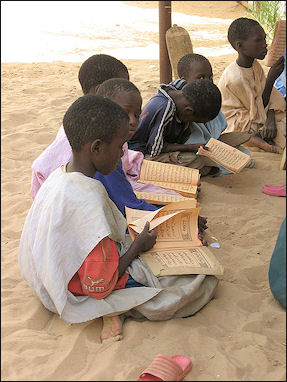 "Madrasahs” are religious schools with an Islamic curriculum in Arabic. Students study the Qur’an, the sayings of the Prophet, Islamic history and Arabic literature and grammar. They are usually but not always are linked with mosques. Traditional ones typically have a central courtyard surrounded by cell-like living quarters (“ hujras” ) used by students, teachers and traveling scholars and buildings with prayer halls and rooms used for instruction.
"Madrasahs” are religious schools with an Islamic curriculum in Arabic. Students study the Qur’an, the sayings of the Prophet, Islamic history and Arabic literature and grammar. They are usually but not always are linked with mosques. Traditional ones typically have a central courtyard surrounded by cell-like living quarters (“ hujras” ) used by students, teachers and traveling scholars and buildings with prayer halls and rooms used for instruction.
With a lack of state schools and money, many poor parents enroll their sons in Qur’anic schools, which are generally free and often given free meals and free places to stay. Traditionally funded by charities that received money from zakat donations,madrasahs don’t need that much money to operate. Teacher’s salaries are low, books are handed down from one class to another. The meals and dormitories from those that provide them are quite basic.
In many predominately Muslim countries, madrasahs serve as schools for the poor while the elite pursue a Western education. Some madrasahs were set up to study the Qur’an and the hadiths; others were set up to teach the principals of Islamic legal thought. Traditional Muslim instruction took place in mosques and revolved around an imam or teacher who stood or sat at a pillar, lecturing on a text while students gather around their feet.
“Maktabs “ or “ kuttabs” are small Qur’anic schools, often only elementary schools, attached to village mosques. World wide about 6 million Muslim study at madrasahs and twice that number study at “maktabs “ or “kuttabs” . These schools have a reputation for being breeding grounds for jihadists. Although most are critical of Western culture only a handful preach violence.
Early History of Islamic Schools
The first official madrasah was established in 1070 in Baghdad, by the Vizier Nizam al-Mulk Hassan bin Ali Tusi (1018-92), a Seljuk wazir, but many date them to an earlier time. Nizam al-Mulk’s school was set up to train experts in Islamic law — muftis and gazis (judges). At that time there was no clerical class and believers followed local leaders who invoked the Qur’an to justify their rule.
Abul Hassan al-Ashari, a 9th century theologian, defined the dogma used a his teachings and that is still in use at many madrasahs today. Among the polemic texts he chose was "The Detailed Explanation in the Refutation of the People of Perdition” and “The Sparks: Refutation of Heretics and Innovators” , texts which rejected the idea of reason being applied to Muslim life.
By the 14th century major Muslim cities in contained dozens of madrasahs and they monopolized higher education of the upper classes that dominate the bureaucracy. They remained the dominant education institution across the Muslim world from Morocco to Indonesia until the appearance of European colonizers.
Later History of Islamic Schools
Samarkand madrasa Shir Dar Colonization and modernization marginalized the madrasahs. As European-style governments, bureaucracies and legal systems were introduced, people with European-style educations replaced graduates of madrasahs as judges and administrators. Madrasahs mainly became places for educating the poor.
Madrasahs kept alive anti-Western sentiments and were breeding grounds for Islamist movements such as the Muslim Brotherhood in the Middle East, Jamaat-Islami (Islamic Party) in South Asia and Nahdatul Ulema (the Movement of Religious Scholars) in Indonesia. Among the madrasah graduates were the ayatollahs of Iran, mujahdeen leaders in the fight against the Soviets in Afghanistan, the Taliban leadership, and prime ministers of Indonesia and Algeria.
The Iranian Revolution elevated religious leaders to the leadership of a country and legitimized and popularized madrasahs as educational institutions and political training grounds. Iranians invited scholars and students from around the Muslim world to their madrasahs to give them training and offer tips on how they cold overthrow the corrupt regimes and monarchies in their home countries. Seeing this as a threat, the rulers of Saudi Arabia and the other Gulf states poured hundreds of millions of dollars into establishing Sunni madrasahs that promoted the conservative Wahabbi brand of Islam.
Madrasahs were given a militant orientation when the Gen. Muhammad Zia ul-Haq of Pakistan established madrasahs instead of regular schools in Afghan refugee camps. This lead to a burst of madrasah building all over the Muslim world and the harnessing of zakat funds to pay for them.
The madrasah for Afghan refugees were also the beginning of the jihadist madrasahs. Some of them were used them as recruiting and training grounds for insurgents who fought in Afghanistan and in Kashmir. See Pakistan.
Shia Islamic Education in Iraq
Alissa J. Rubin wrote in the Los Angeles Times: “The signs began to appear in the Shia neighborhoods of Baghdad and in the larger cities across southern Iraq just a few months after Saddam Hussein's disappearance from the capital. "Classes in Qur’an, Tuesdays, Thursdays and Saturdays," and then, "Classes for Girls and Boys." By the fall of 2003, announcements blared from mosque loudspeakers. One proclaimed, "We are calling all women to join religious school. Secondary school certificates necessary. They will have to pass an exam. Classes start Saturday. Registration is at the Kadhimiya hospital." [Source: Alissa J. Rubin, Los Angeles Times, May 8, 2005]
“And women came. At first in small groups, then dozens, then scores. The clerics who ran some of the schools puzzled over how to accommodate them. In strict Islamic settings, men and women must attend separate classes, sometimes even at different times of the day. "We started out just meeting once a week. Right away, we had to go to twice a week. Now we are trying to add a third class because the women want it," Salah Ubaidi says at a low-slung, modern Arab house in Kadhimiya donated by a wealthy Shia from the United Arab Emirates for use as a religious school. In Iraq, Shia clerics, including Grand Ayatollah Ali Sistani, encourage women to take part in politics and pursue an education, although they expect them to wear head scarves and abayas. In the domestic sphere, women are expected to allow their rights to be governed by Sharia — Islamic law.
Samarkand madrasa Shir Dar courtyard “On that particular day, the instruction is for men. In the classrooms for theology lessons, students sit on rugs, and instead of desks there are rows of low wooden Qur’an holders that — like the stands on which preachers place the Bible — allow the book to stay open. Other classrooms have rows of computers, and just before lunch a class gets underway in how to use the Internet for research.
“In another Shia neighborhood, a 100-year-old school that had been used by the Baath Party as a neighborhood headquarters is searching for a female teacher. Sheik Hassan Tuaima, who teaches women twice a week in two-hour sessions, needs the help. In a neon-lighted classroom, about 25 women ranging from their late teens to their 40s, one or two quieting children they have brought along, listen closely to Hassan's lecture. Several interrupt him with questions, and Hassan looks away as he answers. In Iraqi Muslim culture, it is considered rude for a man to look a woman in the eye when he is speaking to her.
“After class, as they drink juice with Hassan, the students turn to a reporter and several talk animatedly about the hijab controversy in France, where the head covering was banned from public schools. "You need to write very clearly about this," admonishes Fatima, 25, who studied engineering at college. "This is about religious freedom. The hijab is a sign of our faith, like Christians wearing a cross. Why shouldn't we be allowed to wear it?"”
Islamic Schools for Young Children
In the past, madrasahs were treated as a cross between Sunday schools and elementary schools. Students typically joined when they were around seven to read the Qur’an and learn the basics of Islamic teachings. In some places the schools were called “maktab” or “ kuttab” .
Teaching was mainly focused on reciting and memorizing the Qur’an. Teachers typically walked around with a cane. Some rarely used it. Some used it more often. Among the students who were scolded were those who fell asleep while studying and those who came to school in Western-style clothes. Many teachers had read few books other than the Qur’an. They had never seen a movie and advise their student never to see one either.
.jpg)
Indonesian madrassah in 1906 Such methods and spirit remain alive today in madrasahs where students spend much of their time sitting on oriental rugs, rocking back and forth, memorizing passages from the Qur’an. Describing a student at a serious madrasah, Husain Haqqani wrote in Foreign Policy magazine: “In a basement room with plasterless walls adorned by a clock inscribed with “God is Great” in Arabic, 9-year-old Muhammad Tahrir rocked back and forth and recited the...verse of the Qur’an.”
Explaining the education philosophy at his school, one madrasah headmaster told Foreign Policy magazine: “Young minds are not for thinking. We catch them for the madrasahs when they are young and by the time they are old enough to think, they know what to think.” When a student at the school was asked if he was interested in learning math he said, “In the “haddiths” there are many references to how many times Allah has multiplied the reward of jihad. If I knew how to multiply, I would be able top calculate the reward I will earn in the hereafter.”
Students at High Level Islamic Schools
Most madrasahs are set up for boys, middle school age and above. Students generally arrive after they had attended a “maktab” or “ kuttab” , and had learned Arabic even if it wasn’t their first language and had memorized all or large parts of the Qur’an.
In these madrasahs students study things like Arabic grammar and early Islamic history but the core of the curriculum is learning to interpret the Qur’an and the hadiths and understanding the principals of Muslim beliefs and jurisprudence. Instruction typically consists of listening to teachers lecture on texts, with students expected to memorize the texts and understand them. Sometimes students are required to demonstrate they have read a certain text and if they do they receive a certificate, saying they have learned it.
The first stage of instruction, which lasts several years, consists of learning the legal code of the Sharia school to which the madrasah is affiliated. Many students go no further than this, but by this time have learned enough to get jobs in the legal profession. Student who go onto to higher levels study principals in which their are multiple interpretations and are still debated. Some write theses on points of law. Those that finishs this stage are qualified to be qadis (judges) or mufti (legal consultants).
Madrasah curriculum in many places is standardized and based on standard textbooks. A distinction is made between “revealed science” and “rational sciences.” The revealed sciences include the study of Arabic philosophy, Qur’an and Prophetic tradition, orthodox law and theology. The rational sciences are primarily the study of Arabic language and grammar. As a rule the madrasahs reject modernity and teach a curriculum that is little changed from the 11th century.
Some Islamic schools teach extremist Muslim ideology, anti-Semitism and anti-Americanism. Poor and easily influenced, the students are often cast the West is an evil place with uncaring, decadent people who have manipulated the world in ushc as to cause their problems.
There are others that want set up ,more liberal institutions. Anna Kuchment wrote in Newsweek: “The ambitions of some moderates are anything but modest. Hargey has set out to create America's first Islamic university, "a fully fledged alternative to the Ivy League," he calls it. He estimates he will need roughly $100 million to build Crescent University. So far he has raised less than 1 percent of that sum. Nevertheless he says he has recruited a board of directors and is nearing a deal on a 1,000-acre campus outside New York City. He says it would be the first school of its kind anywhere in the world. Never mind the big Islamic universities in countries like Pakistan and Malaysia. "You can't have a free-thinking university in a repressive environment," Hargey says. "A truly pluralistic, progressive Islamic school can exist only in a democratic society." He quotes a favorite line from the Hadith: "The ink of the scholar is greater than the blood of the martyr." If only everyone thought so. [Source:Anna Kuchment, Newsweek, March 10, 2002]
Darululoom Deoband: Influential and Conservative Islamic School
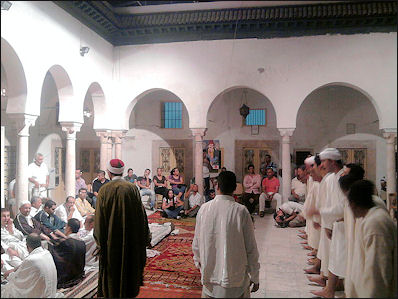
Tunisie Medersa Achouria Darululoom Deoband — in Matkota, Deoband, Uttar Pradesh, India — is one of the world’s most influential Islamic seminaries. Life for students there has changed little in the past 150 years, and many people affiliated with the school are happy with it that way. Not only does the school, founded in 1866, attract students from all over the Islamic world, it also sends teachers to schools not only in Muslim countries but also Europe and the U.S. [Source: AFP, October 7, 2011]
AFP reported: “A large number of Islamic schools — especially in Pakistan and Afghanistan and as far afield as Britain, the United States and South Africa — are either affiliated or ideologically linked to Deoband. The school curriculum is based on a 17th-century syllabus that focuses on Islamic law, jurisprudence and spirituality, and its 6,000 students follow an austere lifestyle which keeps much of the modern world at bay. “Everything here is for the religion, by the religion, of the religion,” said the school’s press spokesman Adeel Siddiqui. “This has been our pattern for over a century and we have produced the finest Islamic scholars to guide the world about Islam. Our model is perfect, so where is the need to modernise it?” he said.
“Life in a conservative bastion: Deoband’s conservative reputation and the success of its alumni in spreading its teachings abroad have led to accusations in the media of links to radical Islamist groups. Deobandi madrassas in Pakistan have been labelled “Taliban nurseries” but the school has always denied any connection with or support for the radicals in Afghanistan. “We have no links with the Taliban. If they associate themselves with us then tell me what can we do about it?” said spokesman Siddiqui. In 2008, the seminary issued a much-publicised fatwa condemning all forms of terrorism as un-Islamic.
“Education, food and accommodation at Deoband are all provided free of cost and the institute relies on donations. Students are restricted from watching television or films. They are not encouraged to read anything except religious texts and must adhere to an all-white dress code with skull cap. Admission is very competitive and many aspirants come from poor backgrounds and see an education at Deoband as a life-changing opportunity. “Getting into Deoband is like finding the door to heaven,” said Muzamil Haq, 17, one of 3,000 hopefuls preparing to take the entrance examination this year. “Who respects a poor man? But if I become a religious teacher then even the rich will hold my hand, they will call me Maulvi (scholar) and listen to what I say.”
“Many graduates end up travelling overseas to take up teaching posts. “There is a great demand for Maulvis in Europe and in the Middle East. We get jobs quickly as Deoband’s education model is regarded as the most authentic and toughest among all the other schools of Islam,” said Ahmed Siddiqui, 34, a student. “More and more Muslims want to learn about their religion. It is our duty to take Allah’s message far and wide.” For an orphan, like 12-year-old Muhammad Aseem, the school can open doors to a future that would otherwise be firmly shut. “My parents died and my uncle decided to send me here. I want to learn to recite the Qur’an but I also want to be a doctor,” said Aseem who sleeps on a torn rug which he shares with four men in a unfurnished room.
Muslim Women and Education
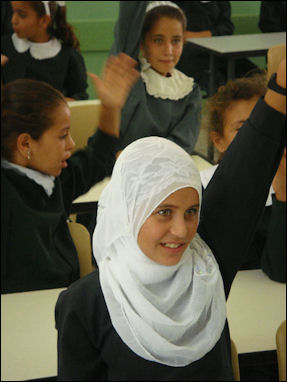
Gaza students Literacy for women is highly encouraged by the traditions of the Prophet Muhammad. Prestigious Al-Azhar University in Cairo has a woman’s college. There are some girl’s madrasahs and other means for females study within Islamic institutions. But in many cases educational opportunities that are offered to males are denied to females, especially under repressive regime like the Taliban. Nearly all religious scholars and interpreters of Islamic law are men. [Source: Carla Power, New York Times magazine, February 25, 2007]
But that wasn’t always the case. Muhammad Akram Nadwi, a Sunni religious scholar, began work in the 1990s on a dictionary of female hadith scholars. When he started he thought he would be lucky to fill a single volume with a few dozen entries but he found many more female scholars than he thought he would. As of 2007, he had 8,000 biographical entries in his 40-volume dictionary.
The entries include a 10th- century Baghdad-born jurist who traveled to Syria and Egypt preaching to women; a 12th-century Egyptian scholar who impressed her male students with her knowledge of a “camel load” of texts; and a 15th-century woman who taught law at the Prophet’s grave in Medina. A 7th-century female jurist from Medina issued fatwas on how the hajj should be carried out. A jurist from Aleppo advised her husband, a famous scholar, how to issue his fatwas. Ummal-darda, a prominent 7th-century scholar from Damascus enjoyed sitting around with men debating religious issues and appears to have been treated as an equal by male scholars. She lectured men and counted a caliph among her students.
After the 16th century the number of women scholars declined markedly as Islamic scholarship and jurisprudence became more formal and oriented towards creating careers in courts and mosques. That appears to have made the female scholars that were around work harder so they could be taken seriously. Akam said the erosion of educational opportunities for Muslim women reflected a “decline in every aspect of Islam” — primarily the result of poor leadership that has let extremism gain too much control and left the Muslim community ignorant and confused.
Image Sources: Wikimedia Commons
Text Sources: Internet Islamic History Sourcebook: sourcebooks.fordham.edu ; Arab News, Jeddah; “Islam, a Short History” by Karen Armstrong; “A History of the Arab Peoples” by Albert Hourani (Faber and Faber, 1991); “World Religions” edited by Geoffrey Parrinder (Facts on File Publications, New York); “Encyclopedia of the World’s Religions” edited by R.C. Zaehner (Barnes & Noble Books, 1959); Metropolitan Museum of Art, Encyclopedia.com, National Geographic, BBC, New York Times, Washington Post, Los Angeles Times, Smithsonian magazine, The Guardian, Al Jazeera, The New Yorker, Time, Newsweek, Reuters, Associated Press, AFP, Library of Congress and various books and other publications.
Last updated April 2024

